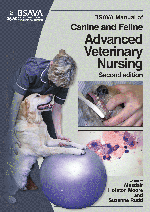
Full text loading...

This chapter provides information on medical nursing at a level beyond that expected of the newly qualified veterinary nurse. The nursing process is emphasized throughout this chapter. This approach is particularly useful for patients with medical conditions which are multifactorial. It is necessary for veterinary nurses to accurately evaluate the stability of new admissions and existing patients in their care. A triage examination briefly reviews each body system in order of importance to highlight abnormal signs and devise a treatment plan. This chapter looks into Nursing the patient with non-specific clinical signs; Nursing the patient with cardiovascular disease; Nursing the patient with respiratory disease; Nursing the patient with gastrointestinal disease; Nursing the patient with neuromuscular disease; Nursing the patient with musculoskeletal disease; Nursing the patient with urogenital disease; Nursing the patient with disorders of the maemopoietic system; Nursing the patient with skin disease; Nursing the patient with ophthalmic disease; Nursing the patient with endocrine disease; and Nursing the patient with cancer.
Advanced medical nursing, Page 1 of 1
< Previous page | Next page > /docserver/preview/fulltext/10.22233/9781905319725/9781905319725.2-1.gif

Full text loading...























